Ask Ethan: how big is the entire unobserved whole universe?
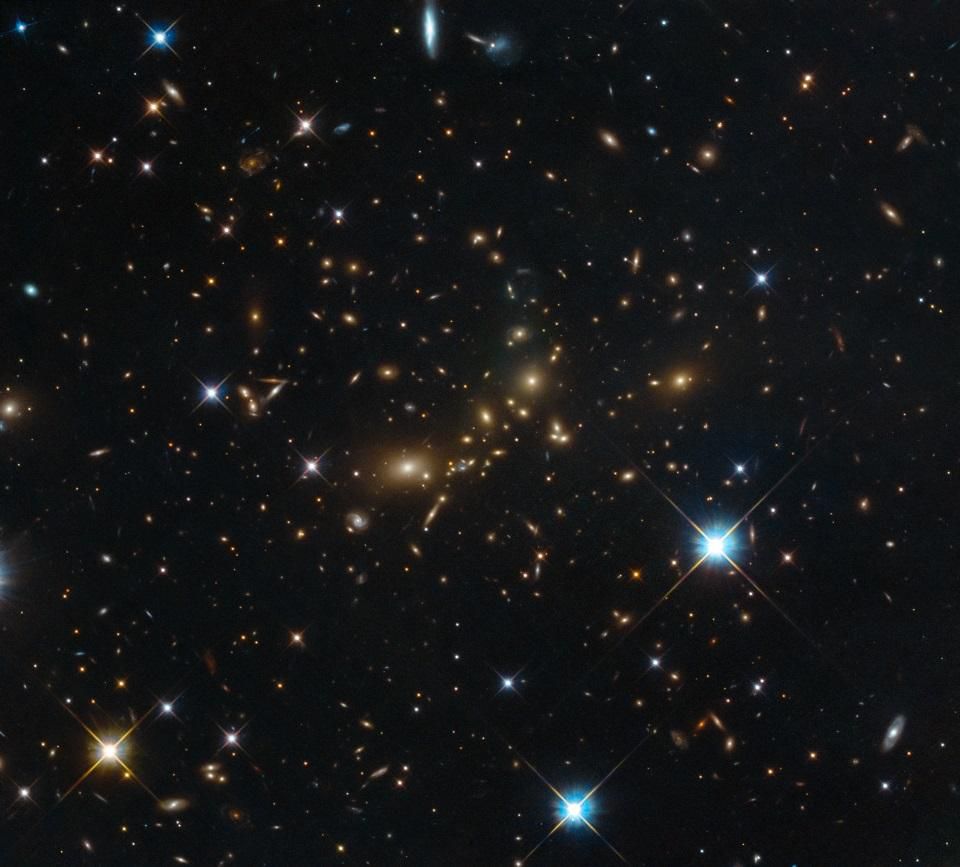
The image obtained from the Hubble telescope demonstrates a massive cluster of galaxies PLCK_G308.3-20.2 glowing brightly in the dark. This is exactly what huge areas of the remote Universe look like. But how far does the known universe go, including the part that we cannot observe?
13.8 billion years ago there was a big bang. The universe was filled with matter, anti-matter, radiation, and existed in a super-hot and super-dense, but expanding and cooling state. To date, its volume, which includes the Universe we observe, has expanded to the fact that its radius is 46 billion light years, and the light that is coming to our eyes for the first time corresponds to the limits of what we can measure. And what is next? What about the unobserved part of the universe? This is what our reader wants to know:
We know the size of the observable universe, since we know its age (at least since the phase transition) and we know how light travels. My question is why mathematics, describing relic radiation and other predictions, cannot tell us the size of the Universe? We know how hot she was and how cold she is now. Does scale not affect these calculations?Oh, if everything was so simple.
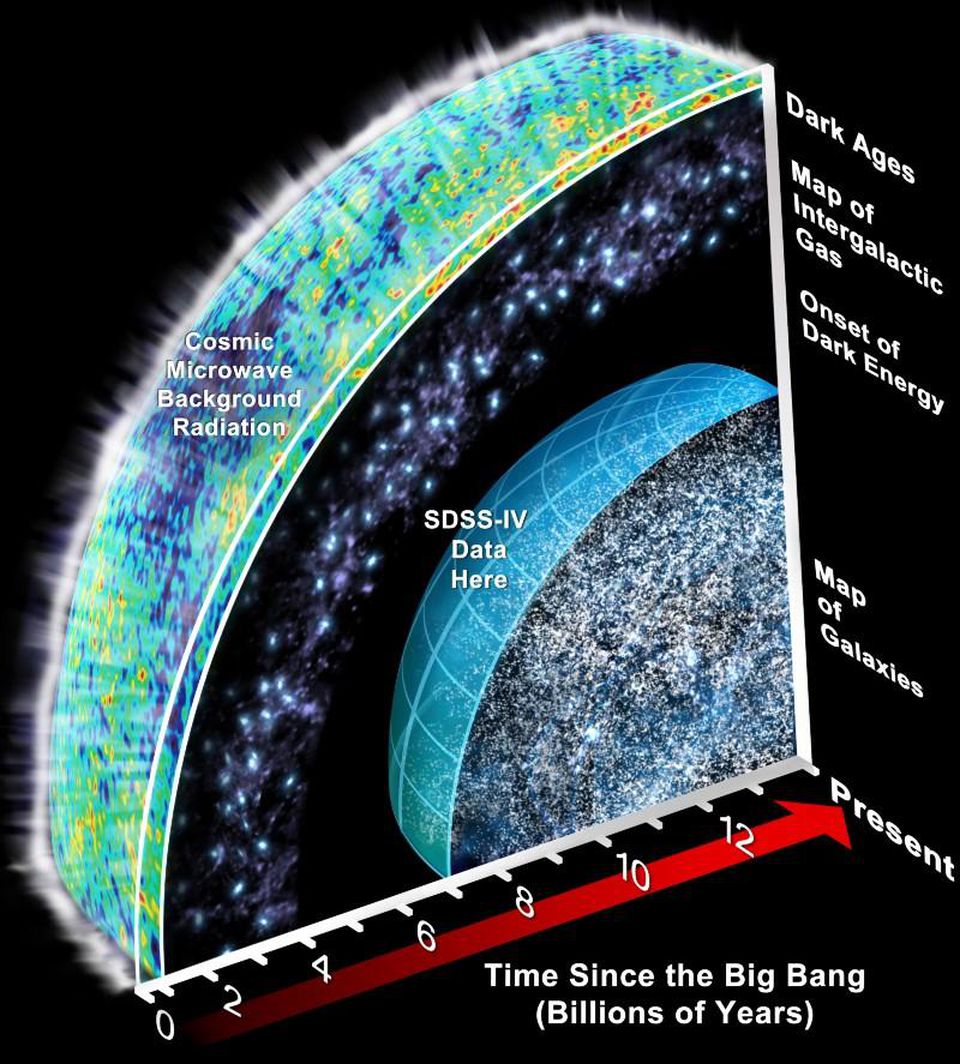
The history of the universe is as well defined as we are able to look into the past with the help of various tools and telescopes. But it can be said, by resorting to tautology, that our observations can give us information only about its observed parts. Everything else has to be guessed, and these guesses are only as good as the underlying assumptions.
Today, the universe is cold and lumpy, but it also expands and has a gravitational effect. Looking far into space, we not only look at far distances, but also see the distant past, because of the finite speed of light. The remote parts of the universe are less lumpy and more homogeneous, they had less time to form larger and more complex structures under the influence of gravity.
')
The early, distant Universe was also hotter. The expanding universe leads to an increase in the wavelength of light propagating through it. With its stretching the light loses energy, cools. This means that in the distant past the Universe was hotter - and we confirmed this fact by observing the properties of remote parts of the Universe.

A study from 2011 (red dots) provides the best evidence available to date that the background radiation temperature was higher in the past. The spectral and temperature properties of light from afar confirm the fact that we live in an expanding space.
We can measure the temperature of today's Universe, 13.8 billion years after the Big Bang, by studying the radiation left over from that hot, dense early state. Today it manifests itself in the microwave part of the spectrum and is known as relic radiation. It fits into the radiation spectrum of an absolutely black body and has a temperature of 2.725 K, and it is fairly easy to show that these observations coincide with surprising accuracy with the predictions of the Big Bang model for our Universe.
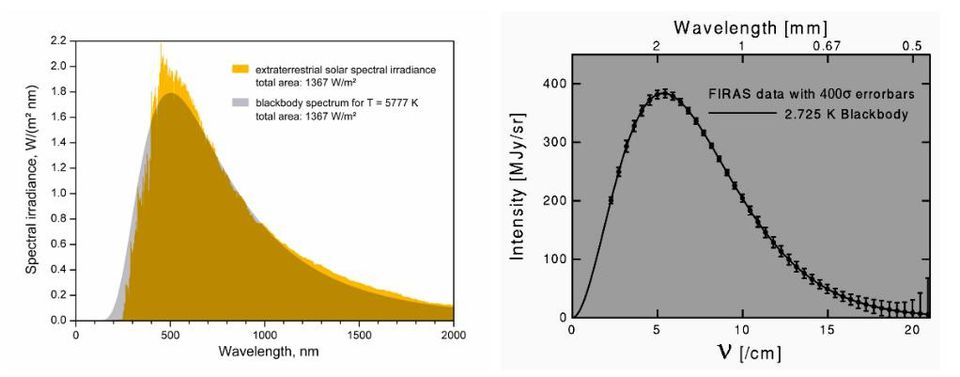
The real light of the Sun (left, yellow curve) and completely black body (gray). Due to the thickness of the solar photosphere, it is more related to black bodies. On the right - the real relic radiation, which coincides with the black body radiation, according to measurements of the COBE satellite. Note that the error spread on the graph on the right is surprisingly small (around 400 sigma). The coincidence of theory with historical practice.
Moreover, we know how the energy of this radiation changes with the expansion of the Universe. The photon energy is inversely proportional to the wavelength. When the universe was two times smaller, the photons left over from the Big Bang had twice the energy; when the size of the universe was 10% of its current, the energy of these photons was 10 times greater. If we want to go back to the moment when the size of the Universe was 0.092% of its current, we find that the Universe was 10 89 times hotter than today: about 3000 K. At these temperatures, the Universe is capable of ionizing all atoms contained in it. Instead of solid, liquid or gaseous substances, all matter in the entire Universe was in the form of ionized plasma.
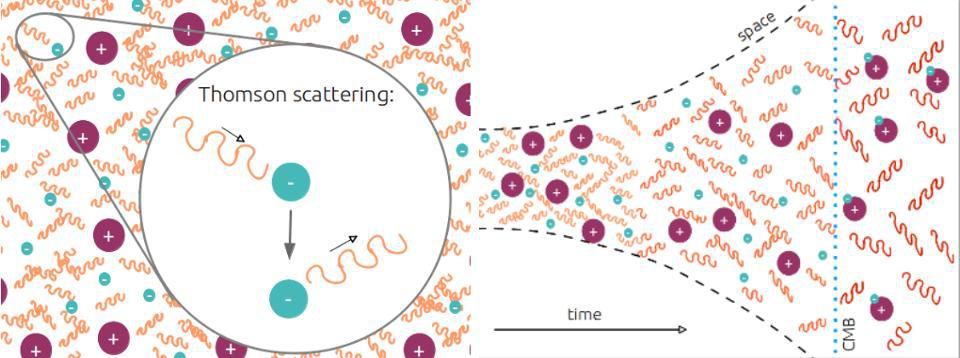
The Universe, in which free electrons and protons collide with photons, turns into a neutral one, transparent to photons, as it cools and expands. On the left - ionized plasma before the emission of the CMB radiation, on the right - the neutral Universe, transparent for photons.
We approach the size of today's Universe by examining three related issues:
- How quickly the Universe is expanding today - this we can measure in several ways.
- How hot the Universe is today - we can find it out by studying relic radiation.
- What the Universe consists of - including matter, radiation, neutrinos, antimatter, dark matter, dark energy, etc.
Using the current state of the universe, we can extrapolate back to the early stages of the hot big bang and come up with values for the age and size of the universe.

Logarithmic graph of the size of the observable universe, in light years, on the amount of time elapsed since the Big Bang. All this applies only to the observable universe.
From the entire set of available observations, including relic radiation, data on supernovae, observations of large-scale structures and acoustic baryon oscillations, we get a picture describing our Universe. After 13.8 billion years after the Big Bang, its radius is 46.1 billion light years. This is the boundary of the observed. Everything that is farther, even moving at the speed of light from the moment of the hot Big Bang, will not have enough time to get to us. Over time, the age and size of the universe increase, and there will always be a boundary of what we can see.

Artistic representation of the observable universe on a logarithmic scale. Note that we are limited in how far we can look into the past, the amount of time that has passed since the hot Big Bang. It is 13.8 billion years old, or (considering the expansion of the Universe) 46 billion light years. Everyone living in our Universe, at any point, will see almost the same picture.
What can we say about the part of the universe that is outside of our observations? We can only assume on the basis of the laws of physics and what we can measure in our, observable part. For example, we see that the Universe on a large scale is spatially flat: it is not twisted either positively or negatively, with an accuracy of 0.25%. If we assume that our laws of physics are formulated correctly, we can estimate how large the Universe can be until it closes itself.
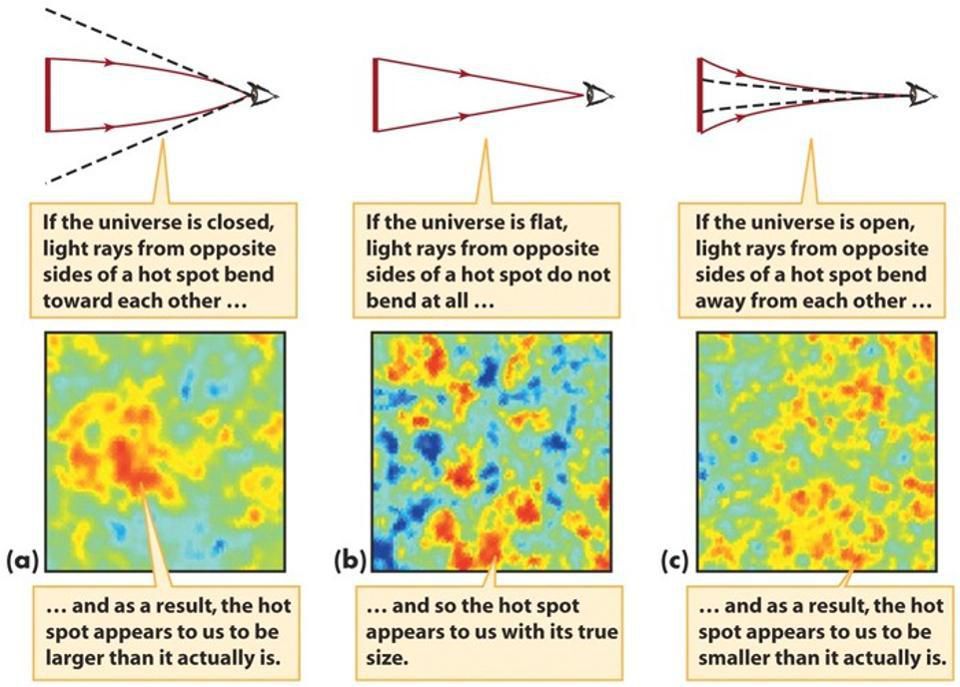
The magnitudes of hot and cold areas and their scales indicate the curvature of the universe. As far as we are able to measure, it looks perfectly flat. Acoustic baryon oscillations provide another method for imposing curvature constraints, and lead to similar results.
Sloan's digital sky survey and Planck satellite give us the best data for today. They say that if the Universe is bent, closing itself on itself, then that part of it that we can see is so indistinguishable from the flat one that its radius should not be less than 250 times the radius of the observed part.
This means that the unobservable Universe, if there are no topological oddities in it, should have a diameter of at least 23 trillion light years, and its volume should be at least 15 million times larger than the one we observe. But if we allow ourselves to reason theoretically, we can quite convincingly prove that the size of the unobservable Universe should significantly exceed even these estimates.

The observable Universe can be 46 billion light-years in all directions from our location, but beyond these limits there is definitely a large part of it, unobserved, perhaps even infinite, similar to what we see. Over time, we can see a little more, but not all of it.
The hot Big Bang may mark the appearance of the observable Universe known to us, but it does not mark the birth of space and time itself. Before the Big Bang, the universe went through a period of cosmic inflation. It was not filled with matter and radiation, and was not hot, but:
- was filled with energy inherent in the space itself,
- expanded with a constant, exponential speed,
- and created a new space so quickly that the smallest possible length, <a
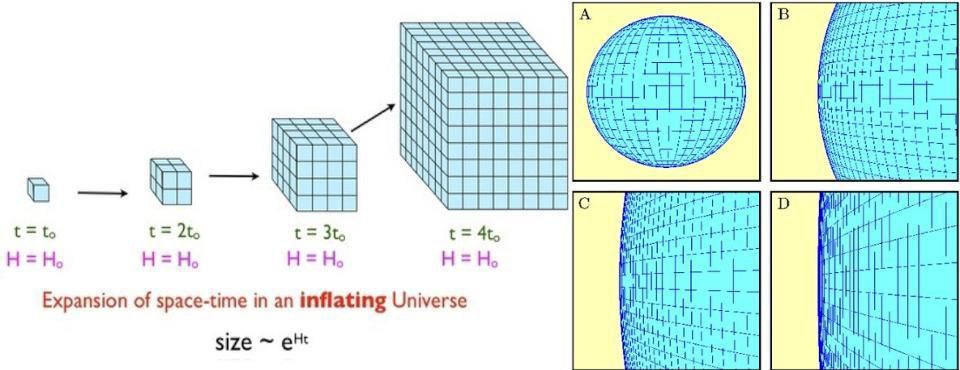
Inflation causes space to expand exponentially, which can very quickly lead to the fact that a curved or non-smooth space will look flat. If the universe is curved, its radius of curvature is at least a hundred times larger than what we can observe.
In our part of the universe, inflation has indeed come to an end. But the three questions to which we do not know the answers have a very strong influence on the real size of the universe, and whether it is infinite:
- How large is the area of the universe after inflation that gave rise to our big bang?
- Is the idea of perpetual inflation true, according to which the universe is expanding indefinitely, at least in some regions?
- How long did the inflation last until it stopped and generated a hot Big Bang?
It is possible that the part of the Universe where inflation went could grow to a size not much larger than what we can observe. It is possible that at any time there will be evidence of the presence of a "margin" on which inflation has ended. But it is also possible that the Universe is more than times observed in googols . Without answering these questions, we will not get an answer to the main one.

A huge number of individual regions in which the Big Bang took place is divided by a space that is constantly growing as a result of perpetual inflation. But we have no idea how to check, measure, or access what lies outside our observable Universe.
Outside of what we can see, most likely, is even more of the Universe, the same as ours, with the same laws of physics, with the same cosmic structures and the same chances for a complex life. Also, the “bubble” in which inflation has ended must have a finite size, despite the fact that an exponentially large number of such bubbles is contained in a larger, expanding space-time. But even if this entire Universe, or Multiverse, may be incredibly large, it may not be infinite. In fact, unless inflation has continued indefinitely, or the universe has not been born infinitely large, it must be finite.
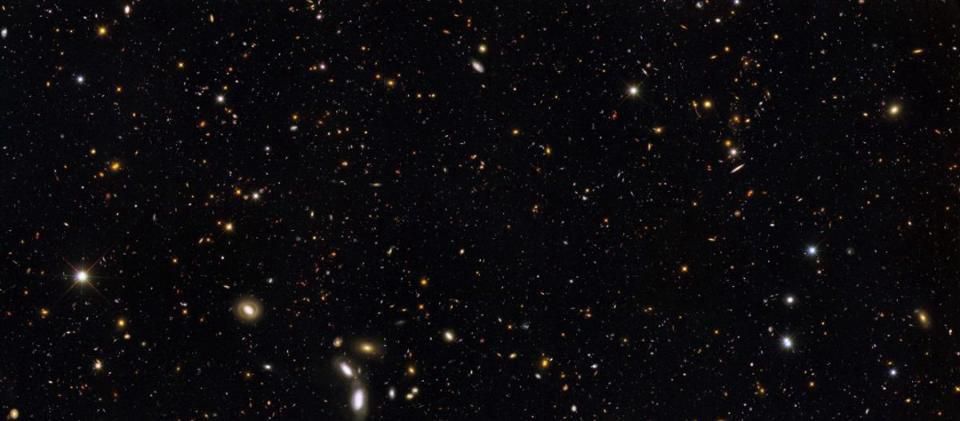
No matter how large the part of the Universe we observe, no matter how far we can look, all this constitutes only a small fraction of what should exist there, beyond.
The biggest problem is that we lack information for a definite answer to a question. We only know how to get access to information available within our observable universe: these 46 billion light years in all directions. The answer to the biggest question, about the finiteness or infinity of the Universe, can be hidden in the Universe itself, but we cannot know a large enough part of it to know for sure. And until we deal with this, or invent a clever scheme for expanding the limits of the possibilities of physics, only probabilities will remain with us.
Source: https://habr.com/ru/post/417549/
All Articles